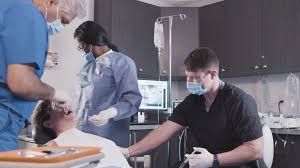Dental emergencies often occur when you least expect them, and understanding how to handle these situations can make all the difference for your patients. While not every dental issue is classified as an emergency, certain situations require immediate attention to alleviate pain or prevent further damage. Here are several common dental emergencies and how they might be addressed in an emergency dental visit.
Severe Dental Pain
Persistent or severe dental pain is a common reason people seek emergency dental care, as it significantly impacts daily life. The pain may result from advanced tooth decay, gum infections, an abscess, or trauma to the teeth or jaw. Patients often report difficulty eating, sleeping, or concentrating, as the discomfort can be constant or worsen over time.
In such cases, urgent dental care is valuable to prevent further complications and find relief. During a consultation, the dentist will identify the root cause of the pain through a thorough examination using X-rays or other diagnostic tools. Once diagnosed, appropriate treatment is provided to protect oral health.
Dental Infection or Abscess
In more serious cases, an infection or dental abscess can cause significant swelling, discomfort, and even systemic symptoms like fever, fatigue, or difficulty breathing. These infections typically occur when bacteria enter the tooth’s pulp or surrounding tissues. If left untreated, the infection can spread beyond the oral cavity to other areas of the body, such as the jaw, neck, or even vital organs. This could result in life-threatening complications.
Emergency dental care often involves draining the abscess to relieve pressure and pain. Dentists are able to prescribe antibiotics to control the infection. They then discuss further treatments, such as root canal therapy or tooth extraction, to restore oral health and prevent recurrence. Acting early avoids serious health risks and encourages faster healing.
Knocked-Out Tooth
A knocked-out tooth is a common dental emergency. It is often caused by trauma or injury. Acting quickly after the injury increases the chances of successful reimplantation. During an emergency visit, a dentist evaluates whether the tooth can be saved. This depends on the time since the injury and the condition of the tooth and socket. Patients are usually advised to keep the tooth moist. This can be done by placing it in milk or holding it in the mouth on the way to the dental office.
Fractured or Broken Tooth
A fractured or broken tooth, especially one with sharp edges or significant damage, can cause several problems. These include pain, sensitivity, difficulty chewing, or injury to surrounding tissues like the tongue or inner cheeks. In some cases, the damage exposes the tooth’s inner layers, increasing the risk of infection or further deterioration.
Emergency dental care addresses these concerns quickly by alleviating pain and preventing further damage. This typically involves smoothing sharp edges, applying protective coverings, or using temporary restorations to stabilize the tooth. Long-term solutions like crowns, veneers, or bonding may be recommended for more severe breaks to restore the tooth’s appearance and functionality while maintaining overall oral health.
Managing Emergency Dental Situations
Understanding these common scenarios helps prepare for emergencies and encourages timely care. Dentists play a valuable role in relieving pain, treating infections, and managing injuries. Clear communication with patients about what to expect during an emergency visit fosters understanding and encourages a smoother process.
- TimesHealthMag Tips For Improving Sleep Quality – Expert Advice For Better Rest!
- How TimesHealthMage Helps Improve Your Lifestyle Habits!
- Mental Health Advice TimesHealthMag For Anxiety Relief – Expert Tips!
- TimesHealthMag Nutrition Facts For A Healthy Lifestyle – Transform Your Health!
- Can You Eat Tuna On A Low Residue Diet – Find Out If It’s Safe For Your Gut!


Leave a Reply